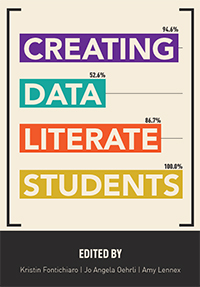
Creating Data Literate Students
Skip other details (including permanent urls, DOI, citation information): Ann Arbor, MI: Michigan Publishing, University of Michigan Library, 2017.
: This work is licensed under a Creative Commons Attribution-NonCommercial-NoDerivatives 4.0 International License. Please contact mpub-help@umich.edu to use this work in a way not covered by the license.
For more information, read Michigan Publishing's access and usage policy.
Table of Contents
- Introduction
- 1 Introduction to statistical literacy —
- 2 Statistical storytelling: The language of data
—
- Experts and novices
- Pure statistical storytelling
- Emotionally evocative storytelling
- Intensifiers and qualifiers
- Teaching the nonfiction writer as narrator
- Results required
- Memory and (mis)information
- Searching
- Context terms
- Associated search terms
- Conclusion
- Resources
- Appendix A: Tips for integrating lessons on unpacking language into your research process
- Appendix B: Causation and correlation worksheet
- Appendix C: Does this sound like correlation, or is there a causal
hint, too?
- 3 Using data in the research process —
- 4 Real world data fluency: How to use raw data —
- 5 Manipulating data in spreadsheets
—
- Finding data
- Downloading your data into a spreadsheet
- Cleaning up the data in your spreadsheet
- Sorting and filtering to discover patterns
- Pivot tables
- Drawing conclusions: Visualize data from a spreadsheet
- Inserting your spreadsheet or graph into Word
- Workarounds for Google Drive
- Conclusion
- Resources
- Appendix A: Spreadsheet tools
- 6 Making sense of data visualization —
- 7 Data presentation: Showcasing your data with charts and graphs —
- 8 Deconstructing data visualizations: What every teen should
know
—
- Think like a designer
- Extending information literacy skills
- A few basic rules of thumb
- What does the data really mean?
- Practice, practice, practice
- Conclusion
- Resources
- Appendix A: Tips for integrating visualization analysis into your classroom
- Appendix B: Practice evaluation with the 5 W’s
- Appendix C: Unpacking visual decisions in an infographic
- Appendix D: Choosing effective visualization types
- 9 Designing your infographic: Getting to design —
- 10 Using data visualizations in the content areas
—
- Why is data visualization instruction important in the classroom?
- Data literacy skills can be the same as literacy skills
- Addressing national standards
- Data visualizations can do all that?
- How does developing data literacy skills help students with
standardized testing?
- So, now are you ready to incorporate data literacy instruction into your content area?
- Resources
- Appendix A: Tips for integrating data visualizations into any content area
- Appendix B: Integrating an infographic about Romeo and Juliet into the ELA classroom
- Appendix C: Integrating an infographic about water into the science classroom
- Appendix D: Integrating an infographic about the Olympics into the social studies classroom
- Appendix E: Integrating an infographic about budgeting into a math classroom
- Appendix F: Using a sample assessment question for an ELA classroom
- Appendix G: Using a sample assessment question for a science classroom
- Appendix H: Using a sample assessment question for a social studies classroom
- Appendix I: Using a sample assessment question for a math classroom
- 11 Teaching data contexts: An instructional lens —
- 12 Diving lessons: Taking the data literacy plunge through action
research
—
- What is action research and evidence-based practice?
- Why action research?
- The action research proposal
- Data collection
- Sorting and analyzing data
- Apply the action or intervention
- Presenting the findings
- Action research in action
- Action research and the connection to data literacy
- Conclusion: Time to get your feet wet
- Resources
- Appendix A: Data instrument comparison
- Appendix B: Tips for integrating action research into your classroom
- Data literacy related standards
-
Data Literacy in the Real World: Conversations & Case
Studies
-
Glossary
- Contributors


